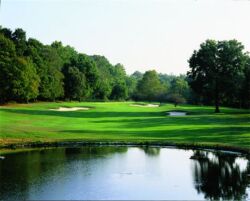Van Cortlandt Park
Van Cortlandt Park
What was here before?
Some twenty thousand years ago, New York was buried beneath massive glaciers. When the ice receded, it left behind the distinct landscape of Van Cortlandt Park—steep ridges, smooth hillsides, and open flats—and exposed its three major rock types: Fordham Gneiss, Inwood Dolomite, and Manhattan Schist. It took about seven thousand years for the ancient Native Americans to arrive in this area, following mastodon, giant beaver, and caribou across North America. By 1000 AD, the Eastern Woodland Indians known as the Lenape began permanent settlements from lower New York State through Delaware. The Weckquaesgeek Lenape occupied this site when, in 1639, the Dutch East India Company brought the first Europeans to settle in the Bronx. In 1646, Dutchman Adriaen Van Der Donck (1620-1655) became the first individual to own land in what is now Van Cortlandt Park. His vast estate “de Jonkeerslandt” gave Yonkers its name. The estate passed through several generations, each of which worked to transform the land into a working plantation. During the 1690s, the 16-acre lake was created when Tibbetts Brook was dammed to power a gristmill.
How did this site become a park?
On December 12, 1888, the City of New York took title to a massive 4,000 acres of parkland in the Bronx, due to the work of the city’s first open space advocacy organization, the New York Parks Association. This unprecedented acquisition led to the formation of Bronx, Claremont, Crotona, St. Mary’s, Van Cortlandt, and Pelham Bay Parks, as well as Crotona, Mosholu, and Bronx-Pelham Parkways. In 1913, this park was named after its long-time residents, the Van Cortlandts. The first public municipal golf course in the country opened here in 1895; a second golf course, the Mosholu Golf Course, opened in 1914. By a special act of the New York State Legislature, the Van Cortlandt Mansion was leased by City of New York to the Society of Colonial Dames and the historic house opened as a museum in 1897. The Parade Ground was created in 1901, and National Guard used it for training exercises until the end of World War I. In 1906, The Bronx Chapter of the Daughters of the American Revolution dedicated a cairn of stones as a memorial to Chief Daniel Nimham, his son Captain Abraham Nimham, and as many as 14 other Stockbridge Indians who were slain there during the Revolutionary War.
Who is this park named for?
This tract of land first took its name in 1694, when Jacobus Van Cortlandt bought the property. The Van Cortlandt Mansion was built in 1748 by his son, Frederick Van Cortlandt, whose family occupied the land until the 1880s. Frederick also established the family burial plot on Vault Hill where, at the onset of the American Revolution, City Clerk Augustus Van Cortlandt hid the city records from the British Army.
Check out your park's Vital Signs
Clean & Safe
Green & Resilient
Empowered & Engaged Users
Share your feedback or learn more about how this park is part of a
Vital Park System
Downloads
Links
Contacts
Van Cortlandt Park Alliance: (718) 601-1460
Mosholu Golf Center and Driving Range: (718) 655-9164
Park Enforcement Patrol: (718) 430-1815
Special Events Permits: (718) 430-1848
Sports Permits: (718) 430-1840
Tennis Permits: (718) 430-1848
Riverdale Equestrian Centre: (718) 548-4848
Urban Park Rangers: (718) 548-0912
Van Cortlandt Golf Course: (718) 543-4595
Van Cortlandt House Museum: (718) 543-3344
Van Cortlandt Pool: (718) 548-2415
Friends of Van Cortlandt Park: (718) 601-1460
Van Cortlandt Nature Center: (718) 548-0912












